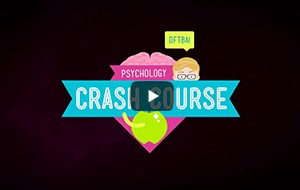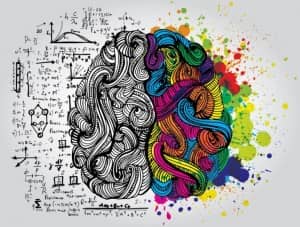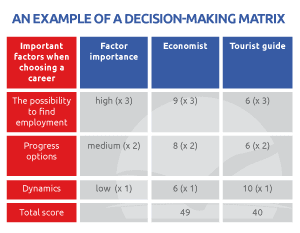What profession should I choose? What university should I choose?
A decision can be defined as a selection of an option from a set of possible options. When making decisions, we can either use logic or rely on intuition. When making important or complex decisions, we apply logic to analyse the current options and assess the advantages and drawbacks of each option in order to choose the best one. The best decision is that which brings the most benefits, i.e. maximises gain and minimises loss.
On the other hand, some decisions are made automatically. On a daily basis, we make most decisions unconsciously, as though we have a personal hidden autopilot. However, if a decision requires logical analysis, and we make the decision unconsciously, such errors are called cognitive bias.
In order to avoid making mistakes when making important decisions, it is important to adopt certain decision-making skills. These skills can significantly facilitate and precipitate the decision-making process when deciding on a profession.
The main steps in decision-making:
1. Defining the nature of a problem
In order to clearly define a problem, it is important to answer the following questions: What is the point of the decision? What is the expected outcome? Take a look at the video that talks about you how complex the human brain is.
 If a question relates to career selection, every future student should be aware of the importance of this decision and be ready to invest significant time and effort in order to make the right decision.
If a question relates to career selection, every future student should be aware of the importance of this decision and be ready to invest significant time and effort in order to make the right decision.
It is important to determine which future profession is important and define them as factors that will be assessed in relation to each option. When selecting a profession, these factors may be: personal interest, the possibility of finding a job, progress options, dynamics, average earnings…
As each individual may regard different features of a future profession as important, different people may find different factors more or less important. Some people wish their job to be dynamic, i.e. not monotonous, some people require room for progress, while others find it important to display their creative and artistic tendencies in their work.
2. Systematic acquisition and analysis of data
In order to reach an adequate decision, it is important to assess all important outcome factors regarding the said decision. To define the key factors, we need to gather as much relevant information as possible, and subsequently sort, analyse and classify it in relation to its importance.
If a future student chooses a profession, or university, they should gather information about the nature of the selected professions, the important abilities and skills for a successful career, the possibility to find employment, the working conditions and options for progress, as well as the universities in question and the study and enrolment conditions.
3. Think creatively
 If we don’t have clearly defined choices for making a decision, creative methods such as brainstorming can be helpful when making an initial option list.
If we don’t have clearly defined choices for making a decision, creative methods such as brainstorming can be helpful when making an initial option list.
The brainstorming method includes generating as many options as possible, without evaluating them.
It’s essential to record all the ideas, no matter how crazy or impossible they may sound.
It is important to list ideas as long as we are inspired, and subsequently assess them and make a list of the best options.
4. Making a list of the best options
After making a list of all potential options, it is important to select those assessed as goals we are likely to achieve and that will generate the most benefits. In order for us to adequately evaluate the advantages and disadvantages of each option, the list should not contain a high number of options.
5. The decision-making matrix
 Once we have created a list of the most favourable options, it is important to assess each activity in relation to the key factors when defining the nature of a problem. During this assessment, the decision-making matrix can be largely helpful. In the matrix, it is necessary to assess each important feature of the future profession, for each profession individually.
Once we have created a list of the most favourable options, it is important to assess each activity in relation to the key factors when defining the nature of a problem. During this assessment, the decision-making matrix can be largely helpful. In the matrix, it is necessary to assess each important feature of the future profession, for each profession individually.
The example displays a decision-making matrix for two professions: economist and tourist guide. If we imagine a future student choosing between these two professions, the first step is to define the important factors (characteristics) of the future profession.
In this case, they would include: the possibility to find employment, progress options and job dynamics. Then, it is necessary to establish which of these features the future student thinks will contribute the most to their satisfaction in a future career. In this case, the most important factor is the possibility to find employment, and the obtained mark is multiplied by 3. Job dynamics is defined as the least important factor.
After establishing the criteria, it is necessary to conduct a systematic acquisition of data (official institutions, people who pertain to a specific profession, teachers, parents, universities, etc.) and analyse it, in order to evaluate each profession on a scale from 1 to 10. Finally, we add the products and the profession with the highest score is the one that should meet our criteria regarding the level of satisfaction in a future career. The matrix results suggest that, taking into account the listed factors, we should choose economics as a career.
Future students face an important decision. After assessing the proposed steps, it’s clear that the decision on one’s future career should be approached seriously and diligently. Think about your wishes, possibilities and ambitions and assess your priorities. After defining what you want and can do, gather information as to the features of the selected professions choose and the one that will satisfy your needs the most.
Author: Milana Jovanov
Literature:
Decision making skills. (2016). Kent.ac.uk. Retrieved 4 May 2016, from https://www.kent.ac.uk/careers/sk/decisionmaking.htm
Kostić, A. (2010). Kognitivna psihologija. Institute for textbook publishing.




